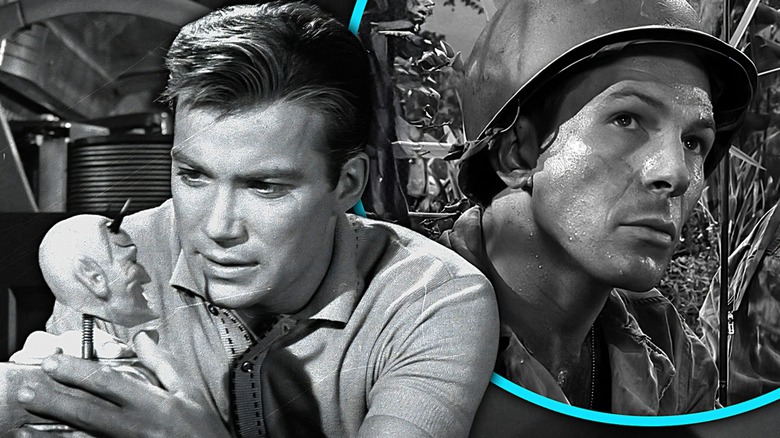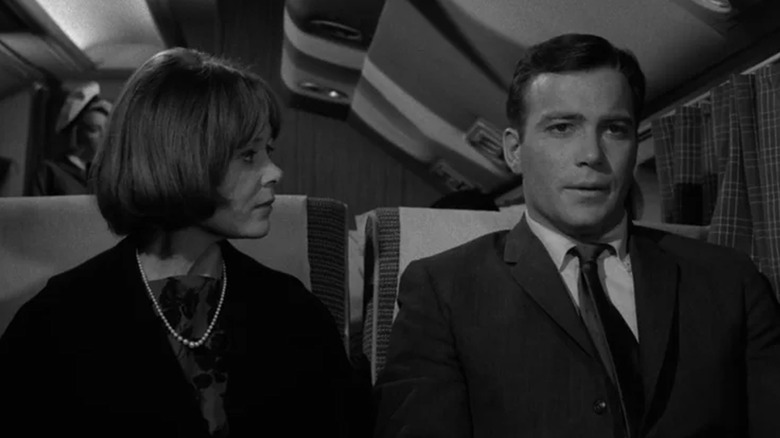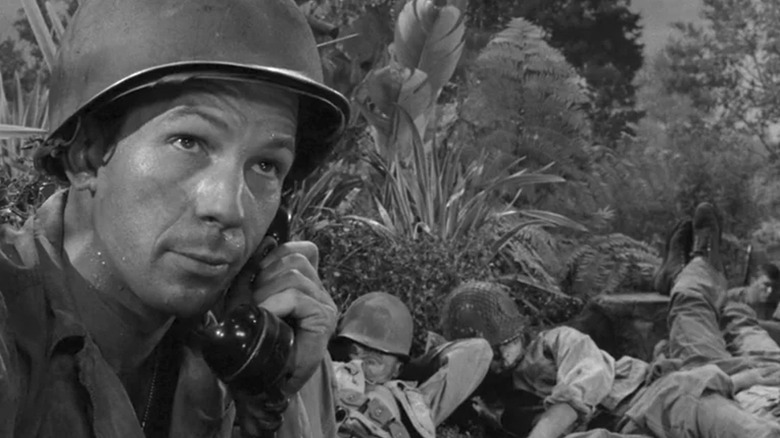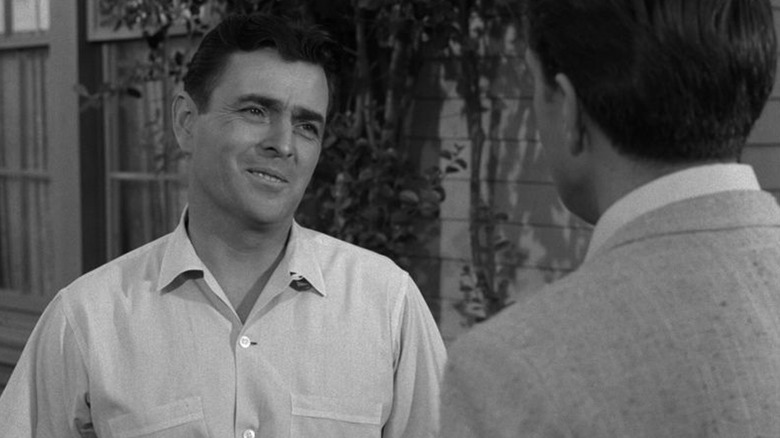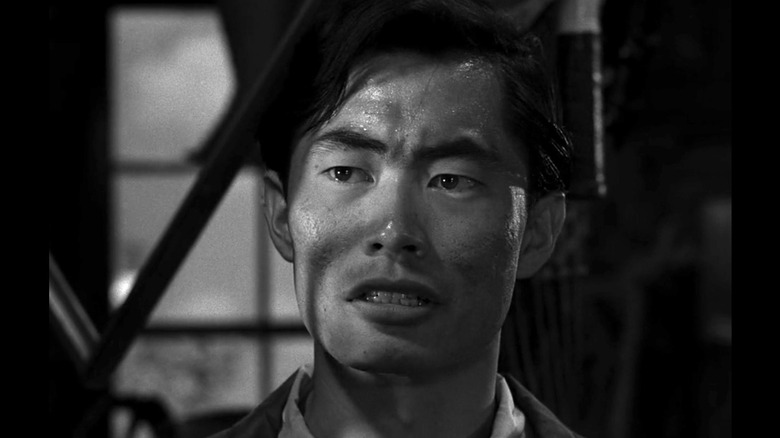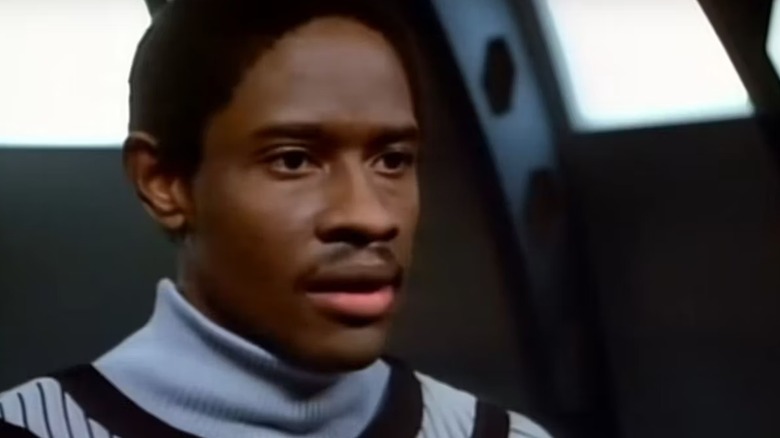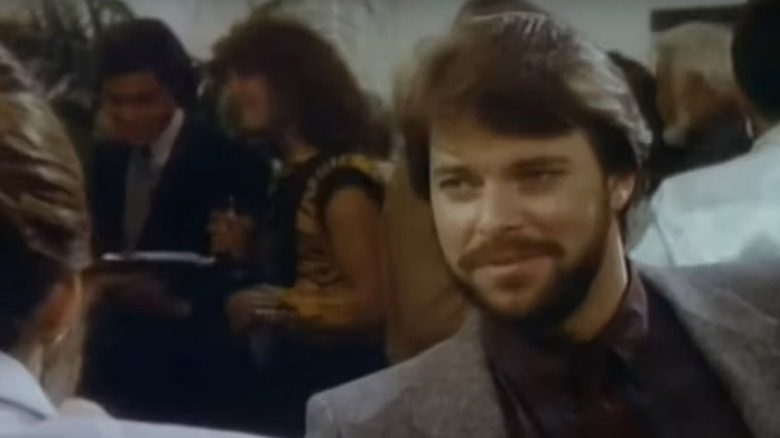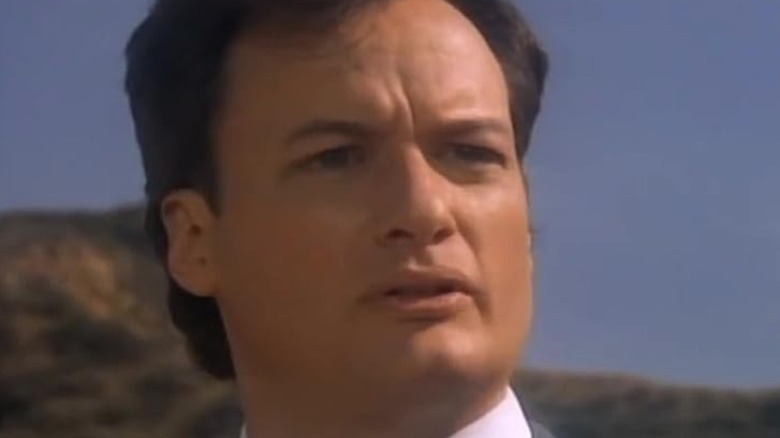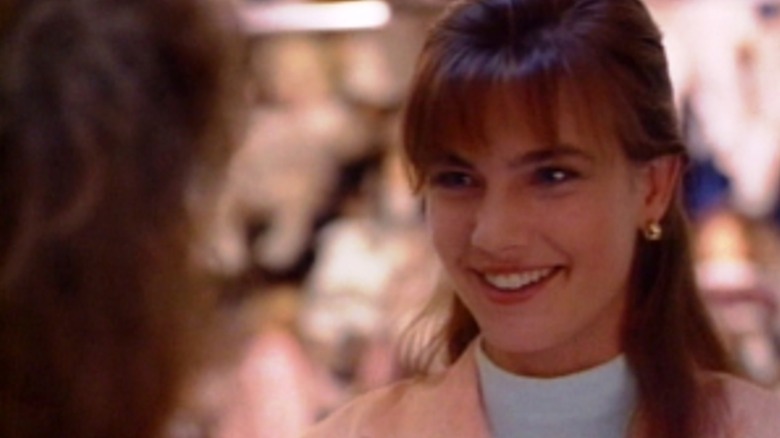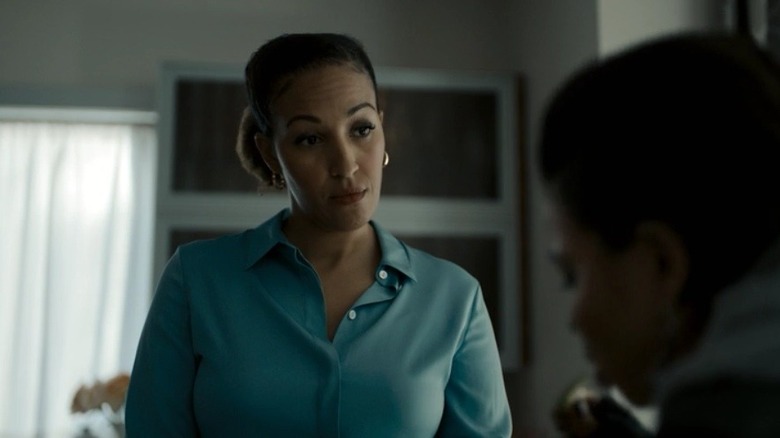The Best Star Trek Actors Who Guest Starred In The Twilight Zone
Two of the most-loved sci-fi franchises of all time have a lot more crossover than you might think. Before starring on "Star Trek: The Original Series," several key members of the enterprise popped up in Rod Serling's seminal series "The Twilight Zone." A few decades later, the same pattern would repeat, only it would be future "Star Trek: The Next Generation" stars cutting their teeth on episodes of the '80s "Twilight Zone" reboot. Even the most recent iteration of the show, Jordan Peele's short-lived but ambitious effort that stalled out after just two seasons, has hosted some great past and future "Trek" actors.
It's worth noting that this list concerns the best "Star Trek" actors, and as such, there are no guarantees that these talented folks are actually great or even memorable in their "Twilight Zone" appearances. Some certainly are, while others have only the briefest of guest spots in mostly-forgotten episodes. We've limited this list to just 11 actors, but you could probably program a 24-hour TV marathon based entirely around episodes of both shows that feature the same actor. Some noteworthy "TOS" performers who didn't make the cut but should be recognized regardless include William Windom, James Gregory, Vic Perrin, Joseph Ruskin, and Susan Oliver, all of whom had memorable but non-starring roles in both shows.
In deciding to focus on "Star Trek" television, we also left out John Cho, who appeared in the not-great 2019 "Twilight Zone" episode "The Wunderkind" and, of course, played Hikaru Sulu on the big screen in Paramount's reboot "Trek" films. You don't need us to tell you that John Cho is great in everything. With that said, here are 11 other talented "Trek" actors who appeared in "The Twilight Zone" over the years, in order of their appearance.
William Shatner
Before he was commanding the U.S.S. Enterprise with cocksure charm and glistening pecs, William Shatner had starring roles in not one but two great "Twilight Zone" episodes. He's most remembered for the second one, season 5's "Nightmare at 20,000 Feet," in which he plays a panicked man (who recently recovered from a breakdown) convinced he saw a gremlin on a plane's wing. Shatner's memorable line reading when he attempts to convince others that the monster is real has been parodied to hell and back, paraphrased by everyone from Ace Ventura to Bart Simpson. The unsubtle bravado of Shatner's performance made it famous, but the episode is also remembered as a paranoid thriller with a classic twist ending.
Shatner's first appearance in "The Twilight Zone" is less referenced, but even better. In the season 2 episode "Nick of Time," he plays one half of a newly married young couple (Patricia Breslin is his wife) that ends up transfixed by a fortune-telling machine at a diner on the way to their honeymoon. Shatner's character briefly becomes fixated on controlling their future through the machine's seemingly all-knowing answers, but they ultimately decide to live with the uncertainty. It's a powerful parable about the wide open future young lovers face, and the choice to either face it together or descend into anxiety and obsession over what could go wrong. Shatner and Breslin memorably make the right choice.
Leonard Nimoy
"A Quality of Mercy" was no doubt an effective anti-war tale when it dropped in 1961, but these days, it's tough to look at the "Twilight Zone" episode and see anything but a white actor in yellowface. That actor thankfully wasn't Leonard Nimoy (though he also crossed racial lines on screen, once playing a Native man on "Gunsmoke"), but the man playing his soldier's superior officer, Dean Stockwell. Stockwell starts the episode as Second Lieutenant Katell, a platoon leader commanding a weary band of U.S. soldiers (including Nimoy's Hansen) at the end of World War II.
When Stockwell tries to push his men into an attack on a group of wounded, surrounded Japanese soldiers, he's suddenly body-swapped and pushed back through time, where he finds himself acting as a Japanese commander about to do the same thing during the fall of the Philippines. The message here is potent, if extremely ill-executed: the lines between friend and foe are thinner than you think, and American brutality on the battlefield isn't morally sound just because it's coming from Americans. A sobering ending drives the point home even further. Nimoy is a relatively small presence in the episode, but he's also the type of actor who I imagine would've made viewers at the time pay a little more attention and ask, "Who's that guy?" They'd know him soon enough.
James Doohan
Before the crew of the enterprise was asking James Doohan's Scotty to beam them up, the actor was playing around with teleport-like technology in a season 4 episode of "The Twilight Zone." The show's fourth season is known as its weakest thanks to episodes that sprawled out to an hour (every other season featured taut 30-minute episodes), and "Valley of the Shadow" is no exception. Still, it's an interesting premise: a reporter (Ed Nelson) discovers a mysterious town where everyone seems keen on making sure he leaves quickly. Soon enough, though, a series of disasters leads to the man taking up residence in the town and discovering that it's a sort of isolated utopia he can never leave.
Doohan plays a townsperson (credited as "Father" in the show, though his character has since been called Johnson) who's only in the episode for a moment, but you'll recognize him from his ultra-high-waisted pants. The episode is an interesting complement to "Star Trek" in that it uses technology that's similar to that of "Trek" transporters and replicators. It's also philosophical in a way that aligns with the later series: the town's futuristic tech is fiercely guarded by its citizens, who don't believe the world at large could handle such powerful tools without descending into violence.
George Takei
Another episode about Japan, America, and the ghosts of World War II, "The Encounter" is a powerful (if flawed) two-hander. A young George Takei delivers a singular performance (he's by far the standout of all the original "Trek" castmates on this list) as a man named Arthur who ends up trapped in an attic with a racist WWII vet (Neville Brand's Fenton) and a katana that has a taste for blood. A sharp script by Martin M. Goldsmith unfolds with tense precision as Arthur, a young stranger looking for work, and Fenton, a depressed man with skeletons in his closet, attempt to find common ground.
"The Encounter" delivers surprise after surprise, all of them realistic and each of them related to the unthinkable events of World War II and the bleak state of race relations in post-war America. Arthur's dad, we find out, was in Pearl Harbor, while Fenton took the sword from a Japanese soldier under dubious circumstances. As the episode unfolds, it becomes clear that the katana, which has the inscription "the sword will avenge me," has a mind of its own. No matter how hard both men try to move past their guilt and defensiveness, this piece of the past won't let them. It's a potent episode with a message about war as a zero-sum game, and it would be nothing without Takei's incredible performance. He also gets to show off his swordsmanship, something he would do again in the classic "Trek" episode "The Naked Time."
Takei's "Twilight Zone" appearance was rarely shown on TV in the 20th century, as its frustrating, both-sides take on Arthur and Fenton's respective roles in World War II was reportedly protested from the time of its release.
Tim Russ
The 1985 version of "The Twilight Zone" doesn't possess the timelessness of the original, and it delivered fewer stone-cold classics, but it's got some gems nonetheless. Part of the show's charm comes from the parade of future stars who showed up for a fragment of an episode: everyone from Morgan Freeman to Helen Mirren to Shelley Duvall popped up in the series. Tim Russ, who would take minor roles in several "Star Trek" properties before landing the part of Vulcan Tuvok in "Star Trek: Voyager," is credited in two different episodes of the series.
The first, "Kentucky Rye," delivers a good old-fashioned wicked-get-punished storyline involving a drunk man who buys a bar that seems too good to be true. Without giving away the episode's satisfying ending, Russ plays part of an emergency services team in a minor yet narratively important role. His second appearance came two years later in the episode "Voices in the Earth," which sees an interstellar scientist (Martin Balsam, who was also in the original "Twilight Zone") plagued by the figures of former Earthlings upon returning to the now-barren land. The episode isn't great, but it does feel more like a "Star Trek" story than a "Twilight Zone" one. Russ appears as Archer, a member of the scientific team.
Jonathan Frakes
"Trek" mainstay Jonathan Frakes appeared in one of the sillier episodes of the '80s "Twilight Zone" reboot, the 1985 fable "But Can She Type?" The episode follows an underappreciated receptionist (Pam Dawber) who gets sucked into another dimension by a malfunctioning Xerox machine. Hilariously, it's a world where secretaries are as high-status and beloved as movie stars. It's there that she meets Frakes' character (credited only as "Single Man"), who is impressed with her career and wants to take her out. As ridiculous as certain aspects of the episode are, it's memorable as the rare "Twilight Zone" story that doesn't leave its main character trapped in the worst timeline.
Frakes has also stepped behind the camera on "The Twilight Zone," albeit after he had already gained fame as fan favorite character William T. Riker on "Star Trek: The Next Generation." In 2002, Frakes directed the 11th episode of the second "Twilight Zone" reboot, "The Lineman," which focuses on a telephone line worker (a pre-"Entourage" Jeremy Piven) who gets psychic powers. Frakes is a great director, but "The Lineman" is not one of the higher-rated episodes of the series.
Brent Spiner and John de Lancie
One of at least two "Trek" crossover two-for-ones in "Twilight Zone" history, "Dead Run" features two of the most talented scene-stealers from "Star Trek: The Next Generation" (and "Star Trek: Picard," for that matter). Data actor Brent Spiner and Q himself, John de Lancie, both appear in this episode, which is a standout entry in the '80s "Twilight Zone" reboot. "Dead Run" is about a truck driver (Steve Railsback) whose lack of job opportunities leads him to become a ferryman to Hell, a gig he takes reluctantly and soon grows disillusioned with as he figures out that some people on the "low road" might not actually deserve to be there.
"Dead Run" is interesting for several reasons, from its use of the "afterlife as bureaucracy" idea (which would later end up in everything from "Beetlejuice" to "Good Omens" and "The Good Place") to its critical commentary on both punishment-heavy organized religion and America's faulty justice system. Spiner appears as a draft dodger consigned to hell, while De Lancie plays a dispatcher working with the transport team. Just one year later, both would step into their career-defining roles on "Star Trek: The Next Generation."
Terry Farrell
The only "Trek" star to land a lead role in the 1980s "Twilight Zone" series, Terry Farrell led the cast of a revamp of one of the original series' best episodes. Several years before she was breaking new ground as queer, genderbending Jadzia Dax in "Star Trek: Deep Space Nine," Ferrell played the woman at the center of "The After Hours," a surprisingly unnerving remake of a Rod Serling classic. In case you haven't seen the excellent original, we'll keep the details of "The After Hours" quiet, but it's worth noting that both versions of the story feature a woman named Marsha whose visit to a department store is plagued by eerie mannequins.
There are a few key differences between the two episodes, including their tone. While the original "After Hours" reveals its mythology as a sort of wistful magical realist premise, the '80s version takes a horror-tinged approach, with Marsha's encounters with the mannequin beings growing more aggressive as the episode wears on. Farrell puts in a solid performance here, but it's impossible for "The After Hours" to live up to the original, which is one of the best episodes of a classic sci-fi show in its prime.
Tawny Newsome and Paul F. Tompkins
Incredibly, "Dead Run" isn't the only "Twilight Zone" episode to feature two future costars in a "Star Trek" series. In 2020, "Star Trek: Lower Decks" voice actors Tawny Newsome and Paul F. Tompkins appeared together in a season 2 episode of Jordan Peele's reboot series just two months before making their "Trek" debut. The episode, "Ovation," opens with a pop star passing a mysterious medallion to a busker named Jasmine (Jurnee Smollett) before dying. Jasmine's fortunes soon change, and on the road to fame, she goes on a talk show hosted by Paul F. Tompkins' character. Newsome plays her sister, Zara, who's caught in the crossfire of Jasmine's newfound celebrity.
Newsome and Tompkins don't have scenes together in "Ovation," but they'd share plenty of screen time in "Star Trek: Lower Decks," where Newsome stars as rebellious nepo baby ensign Beckett Mariner and Tompkins plays hilariously unhelpful bird-man therapist Dr. Migleemo. Though neither talented comedic actor gets the screen time they deserve in "Ovation," it's a solid episode of the so-so reboot series — one that's bolstered by great performances from Smollett and Newsome, assured directing from Ana Lily Amirpour, and a wheel-of-fortune plotline that would be right at home in the original "Twilight Zone."
